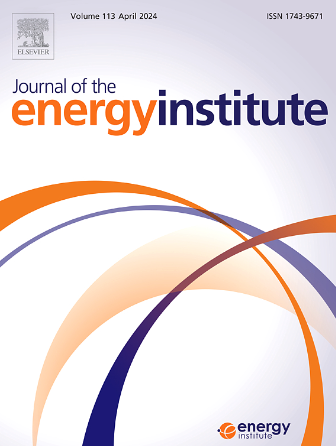热解褐煤和废轮胎用于生产液体燃料
IF 5.6
2区 工程技术
Q2 ENERGY & FUELS
引用次数: 0
摘要
使用固定床反应器对所有共热解产物(焦油、煤气和焦炭)进行全面评估,以进行预期的升级和技术经济分析,旨在将热解商业化并将其整合到传统系统中。研究了废轮胎煤比、温度等参数对热解过程的影响。本研究研究了煤和废轮胎(WT)的共热解,以确定其在500°C的固定床反应器中在广泛的原料比例(WT与煤组合的10%、30%、50%、70%和90%)范围内对产品的影响。在此基础上,确定了煤与废轮胎配比为50:50,略低于70:30的混合比例时,最佳产油率为44%,总发热量为41.00 MJ/kg。研究结果表明,原料的质量比对含氧化合物转化为碳氢化合物(HC)至关重要。当WT/煤配比接近50:50时,产液率、有机相、芳烃和脂肪族均有所增加。wt和煤(50:50)的火油产量为44%,而单独使用煤的火油产量为19%。同样,在相同的混合比例下,含氧化合物减少了65%,在煤与WT 50:50的混合比例下,火油的较高热值(41.00 MJ/kg)与WT (45.00 MJ/kg)相当,与汽油柴油相当。煤中WT的掺入对不可冷凝气体产生了显著的有利协同作用。与单独使用煤炭相比,WT的引入增加了氢(H2)和甲烷(CH4),同时增加了碳氢化合物,同时减少了碳氧化物。WT与煤的掺入也增强了煤的焦炭性质,表现为碳含量、HHV和灰分含量的提高。50:50的混合比例被认为是最优的发现后,显着的液体产量在这个比例。最后,对热解油进行气相色谱-质谱(GCMS)和傅里叶变换红外光谱(FTIR)分析,对热解气进行气相色谱-导热检测(GCTD)。本文章由计算机程序翻译,如有差异,请以英文原文为准。
Pyrolysis of lignite coal and waste tires for liquid fuel production
A thorough evaluation of all co-pyrolysis products (pyro-oil, gas, and char) using a fixed bed reactor is required for prospective upscaling and techno-economic analysis aimed at commercializing pyrolysis and integrating it into traditional systems. The study investigated the effects of many parameters, including the waste tire to coal ratio and temperature. This study investigates the co-pyrolysis of coal and waste tires (WT) to determine its influence on products throughout a broad range of feedstock ratios (10, 30, 50, 70, and 90 wt% of WT combined with coal) in a fixed bed reactor set at 500 °C. Based on the findings, it was determined that the optimal oil yield of 44 % and maximum gross calorific values of 41.00 MJ/kg were achieved with a coal to waste tires ratio of 50:50 which was slightly lower than 70:30 blending ratio. The findings demonstrated that the mass ratio of the feedstock was critical in the conversion of oxygenates into hydrocarbons (HC). Liquid yield, organic phase, aromatics, and aliphatic all increased when the WT/coal blending ratio approached 50:50. Pyro-oil output was 44 wt% with WT and coal (50:50), compared to 19 wt% with coal alone. Similarly, at comparable blend ratios, oxygenates were reduced by 65 %, and the higher heating value (HHV) of pyro-oil (41.00 MJ/kg) at 50:50 coal and WT blending ratio and matched that of WT (45.00 MJ/kg) and comparable with Petro-diesel. The incorporation of WT into coal resulted in a notable advantageous synergy for non-condensable gas. The introduction of WT augmented hydrogen (H2) and methane (CH4), alongside increased HCs, while diminishing carbon oxides compared to coal alone. The integration of WT into coal also enhanced the char properties, manifesting in heightened carbon content, HHV, and diminished ash content. The 50:50 blending ratio is deemed optimal following the discovery of a notable liquid yield at this proportion. Finally, Gas Chromatography-Mass Spectrometry (GCMS) and Fourier Transform Infrared Spectroscopy (FTIR) analyses were conducted on the pyro-oil, while Gas Chromatography-Thermal Conductivity Detection (GCTD) was employed for the pyro gas.
求助全文
通过发布文献求助,成功后即可免费获取论文全文。
去求助
来源期刊

Journal of The Energy Institute
工程技术-能源与燃料
CiteScore
10.60
自引率
5.30%
发文量
166
审稿时长
16 days
期刊介绍:
The Journal of the Energy Institute provides peer reviewed coverage of original high quality research on energy, engineering and technology.The coverage is broad and the main areas of interest include:
Combustion engineering and associated technologies; process heating; power generation; engines and propulsion; emissions and environmental pollution control; clean coal technologies; carbon abatement technologies
Emissions and environmental pollution control; safety and hazards;
Clean coal technologies; carbon abatement technologies, including carbon capture and storage, CCS;
Petroleum engineering and fuel quality, including storage and transport
Alternative energy sources; biomass utilisation and biomass conversion technologies; energy from waste, incineration and recycling
Energy conversion, energy recovery and energy efficiency; space heating, fuel cells, heat pumps and cooling systems
Energy storage
The journal''s coverage reflects changes in energy technology that result from the transition to more efficient energy production and end use together with reduced carbon emission.
 求助内容:
求助内容: 应助结果提醒方式:
应助结果提醒方式:


